
Eddy covariance
Encyclopedia
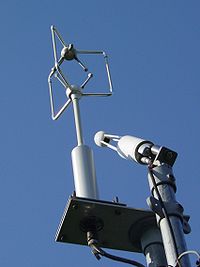
Statistics
Statistics is the study of the collection, organization, analysis, and interpretation of data. It deals with all aspects of this, including the planning of data collection in terms of the design of surveys and experiments....
method used in meteorology
Meteorology
Meteorology is the interdisciplinary scientific study of the atmosphere. Studies in the field stretch back millennia, though significant progress in meteorology did not occur until the 18th century. The 19th century saw breakthroughs occur after observing networks developed across several countries...
and other applications that analyzes high-frequency wind
Wind
Wind is the flow of gases on a large scale. On Earth, wind consists of the bulk movement of air. In outer space, solar wind is the movement of gases or charged particles from the sun through space, while planetary wind is the outgassing of light chemical elements from a planet's atmosphere into space...
and scalar
Scalar (physics)
In physics, a scalar is a simple physical quantity that is not changed by coordinate system rotations or translations , or by Lorentz transformations or space-time translations . This is in contrast to a vector...
atmospheric data series, and yields values of flux
Flux
In the various subfields of physics, there exist two common usages of the term flux, both with rigorous mathematical frameworks.* In the study of transport phenomena , flux is defined as flow per unit area, where flow is the movement of some quantity per time...
es of these properties. Such flux
Flux
In the various subfields of physics, there exist two common usages of the term flux, both with rigorous mathematical frameworks.* In the study of transport phenomena , flux is defined as flow per unit area, where flow is the movement of some quantity per time...
measurements are widely used to estimate momentum
Momentum
In classical mechanics, linear momentum or translational momentum is the product of the mass and velocity of an object...
, heat
Heat flux
Heat flux or thermal flux is the rate of heat energy transfer through a given surface. The SI derived unit of heat rate is joule per second, or watt. Heat flux is the heat rate per unit area. In SI units, heat flux is measured in W/m2]. Heat rate is a scalar quantity, while heat flux is a vectorial...
, water, and carbon dioxide exchange, as well as exchange of methane and other trace gases
.
The technique is also used extensively for verification and tuning of global climate model
Global climate model
A General Circulation Model is a mathematical model of the general circulation of a planetary atmosphere or ocean and based on the Navier–Stokes equations on a rotating sphere with thermodynamic terms for various energy sources . These equations are the basis for complex computer programs commonly...
s, mesoscale and weather models, complex biogeochemical and ecological models, and remote sensing estimates from satellites and aircraft. The technique is mathematically complex, and requires significant care in setting up and processing data. To date, there is no uniform terminology or a single methodology for the Eddy Covariance technique, but much effort is being made by flux measurement networks (e.g., Fluxnet, Ameriflux, ICOS, CarboEurope, Fluxnet Canada, NEON, and iLEAPS) to unify the various approaches.
General principles
Representation of the air flow in the atmospheric boundary layerAir flow can be imagined as a horizontal flow of numerous rotating eddies, that is, turbulent vortices of various sizes, with each eddy having horizontal and vertical components. The situation looks chaotic, but vertical movement of the components can be measured from the tower.
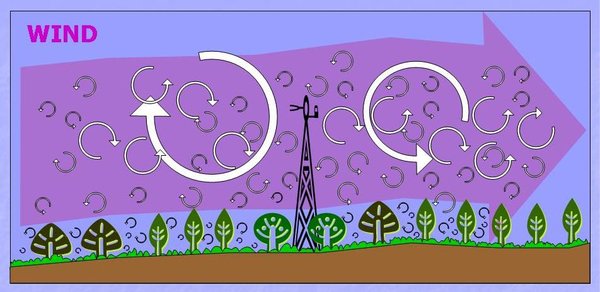
Physical meaning of the eddy covariance method
At one physical point on the tower, at Time1, Eddy1 moves parcel of air c1 down at the speed w1. Then, at Time2, Eddy2 moves parcel c2 up at the speed w2. Each parcel has a concentration, temperature, and humidity. If these factors, along with the speed are known, we can determine the flux. For example, if one knew how many molecules of water went down with eddies at Time 1, and how many molecules went up with eddies at Time2, at the same point, one could calculate the vertical flux of water at this point over this time.
So, vertical flux can be presented as a covariance of the vertical wind velocity and the concentration of the entity of interest.
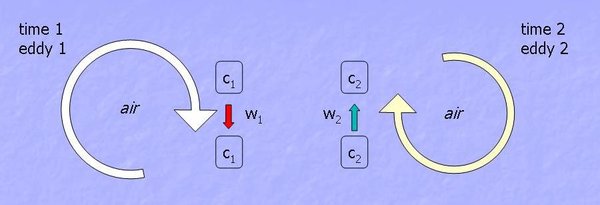
Mathematical foundation
In mathematical terms, "eddy flux" is computed as a covarianceCovariance
In probability theory and statistics, covariance is a measure of how much two variables change together. Variance is a special case of the covariance when the two variables are identical.- Definition :...
between instantaneous deviation in vertical wind speed (w') from the mean value (w-overbar) and instantaneous deviation in gas concentration, mixing ratio (s'), from its mean value (s-overbar), multiplied by mean air density (ρa). Several mathematical operations and assumptions, including Reynolds decomposition, are involved in getting from physically complete equations of the turbulent flow to practical equations for computing "eddy flux", as shown below.
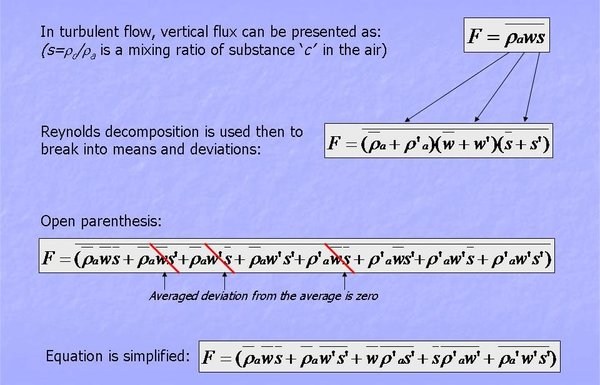
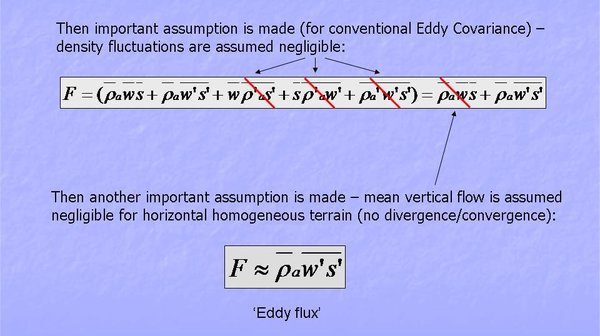
Major assumptions
- Measurements at a point can represent an upwind area
- Measurements are done inside the boundary layer of interest
- Fetch/flux footprintFlux footprintFlux footprint is an upwind area where the atmospheric flux measured by an instrument is generated. Specifically, the term flux footprint describes an upwind area “seen” by the instruments measuring vertical turbulent fluxes, such that heat, water, gas and momentum transport generated in this area...
is adequate – fluxes are measured only at area of interest - Flux is fully turbulent – most of the net vertical transfer is done by eddies
- Terrain is horizontal and uniformed: average of fluctuations is zero; density fluctuations negligible; flow convergence & divergence negligible
- Instruments can detect very small changes at high frequency, ranging from minimum of 5 Hz and to 40 Hz for tower-based measurements
Eddy covariance processing software
Currently (2011) there are many software programsto process eddy covariances data and derive quantities such as heat, momentum, and gas fluxes. The programs range significantly in complexity, flexibility, number of allowed instruments and variables, help system and user support. Some programs are open-source software
Open-source software
Open-source software is computer software that is available in source code form: the source code and certain other rights normally reserved for copyright holders are provided under a software license that permits users to study, change, improve and at times also to distribute the software.Open...
, while others are closed-source or proprietary
Proprietary software
Proprietary software is computer software licensed under exclusive legal right of the copyright holder. The licensee is given the right to use the software under certain conditions, while restricted from other uses, such as modification, further distribution, or reverse engineering.Complementary...
.
Examples include free fully supported and documented open-source software such as EddyPro; free unsupported open-source programs such as ECO2S and ECpack; free closed-source packages such as EdiRe, TSA, TK2, Alteddy, and EddySoft. Eddy covariance processing algorithms can also be implemented in commercial software such as Matlab
MATLAB
MATLAB is a numerical computing environment and fourth-generation programming language. Developed by MathWorks, MATLAB allows matrix manipulations, plotting of functions and data, implementation of algorithms, creation of user interfaces, and interfacing with programs written in other languages,...
.
Summary
In a nutshell, the 3D wind and another variable (usually gas concentration, temperature or momentum) are decomposed into meanAverage
In mathematics, an average, or central tendency of a data set is a measure of the "middle" value of the data set. Average is one form of central tendency. Not all central tendencies should be considered definitions of average....
and fluctuating components. The covariance is calculated between the fluctuating component of the vertical wind and the fluctuating component of gas concentration. The measured flux is proportional to the covariance.
The area from which the detected eddies originate is described probabilistically and called a flux footprint
Flux footprint
Flux footprint is an upwind area where the atmospheric flux measured by an instrument is generated. Specifically, the term flux footprint describes an upwind area “seen” by the instruments measuring vertical turbulent fluxes, such that heat, water, gas and momentum transport generated in this area...
. The flux footprint area is dynamic in size and shape, changing with wind direction, thermal stability and measurements height, and has a gradual border.
The effect of sensor separation, finite sampling length, sonic path averaging, as well as other instrumental limitations, affect frequency response of the measurement system and may need a co-spectral correction, especially noticeable with closed-path instruments and at low heights below 1-1.5 m.
See also
- Eddy
- Ecosystem respirationEcosystem respirationEcosystem respiration is the sum of all respiration occurring by the living organisms in a specific ecosystem.Ecosystem respiration is typically measured in the natural environment, such as a forest or grassland field, rather than in the laboratory...
- EvaporationEvaporationEvaporation is a type of vaporization of a liquid that occurs only on the surface of a liquid. The other type of vaporization is boiling, which, instead, occurs on the entire mass of the liquid....
- EvapotranspirationEvapotranspirationEvapotranspiration is a term used to describe the sum of evaporation and plant transpiration from the Earth's land surface to atmosphere. Evaporation accounts for the movement of water to the air from sources such as the soil, canopy interception, and waterbodies...
- Greenhouse gas emissions
- Heat fluxHeat fluxHeat flux or thermal flux is the rate of heat energy transfer through a given surface. The SI derived unit of heat rate is joule per second, or watt. Heat flux is the heat rate per unit area. In SI units, heat flux is measured in W/m2]. Heat rate is a scalar quantity, while heat flux is a vectorial...
- FluxNetFluxNetFluxNet is a global network of micrometeorological tower sites that use eddy covariance methods to measure the exchanges of carbon dioxide, water vapor, and energy between the biosphere and atmosphere. Fluxnet is a global 'network of regional networks' that serves to provide an infrastructure to...
- Latent heat flux
- TranspirationTranspirationTranspiration is a process similar to evaporation. It is a part of the water cycle, and it is the loss of water vapor from parts of plants , especially in leaves but also in stems, flowers and roots. Leaf surfaces are dotted with openings which are collectively called stomata, and in most plants...
Further reading
- Burba, G.G., and D.J. Anderson, 2010. A Brief Practical Guide to Eddy Covariance Flux Measurements: Principles and Workflow Examples for Scientific and Industrial Applications. LI-COR Biosciences, Lincoln, USA, 211 pp.
- Foken, T. 2008. Micrometeorology, Springer-Verlag, Berlin, Germany, 308 pp.
- Lee, X., W. Massman, and B. Law. 2004. Handbook of Micrometeorology. Kluwer Academic Publishers, The Netherlands, 250 pp.

